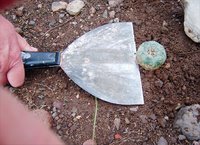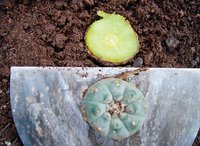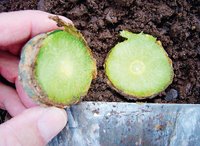Lophophora williamsii (peyote) populations have diminished in large areas of South Texas where peyoteros harvest the cactus for ceremonial use by the Native American Church. Habitat destruction caused by urban development, rootplowing, etc., account for much of the reduction, but the regulated commercial harvest of peyote is also taking its toll. Some harvesters cut the peyote too low (it can be very hard to tell where the shoot ends and the root begin) - consequently many of the decapitated plants will not regenerate new stems and are left to die.
To address this problem Martin Terry and James D. Mauseth have investigated the proper technique for harvesting peyote, and found that the cactus must be cut off at or immediately below its base, leaving the subterranean portion of the plant (including all or most of the subterranean part of the stem) in the ground to regenerate new crowns. Their harvesting technique is outlined below.
 Plant about to be cut transversely at the base of the crown (the photosynthetic part of the stem), i.e., at ground level.
Plant about to be cut transversely at the base of the crown (the photosynthetic part of the stem), i.e., at ground level.
 Cut has been made parallel to the ground surface, and the harvested crown (below) has been removed from the subterranean portion of the stem (above, remaining in the ground). The cut surface shows a cross section of the vascular cylinder (ring of yellow tissue near center of stem), the pith within the vascular cylinder, and the yellowish green parenchymal tissue of the cortex of the stem (between vascular ring and epidermis).
Cut has been made parallel to the ground surface, and the harvested crown (below) has been removed from the subterranean portion of the stem (above, remaining in the ground). The cut surface shows a cross section of the vascular cylinder (ring of yellow tissue near center of stem), the pith within the vascular cylinder, and the yellowish green parenchymal tissue of the cortex of the stem (between vascular ring and epidermis).
 The underside of the harvested crown (left) shows a very narrow (2–3 mm wide) ring of bark at the perimeter of the cut surface, indicating that the cut was barely below the base of the crown, in the uppermost portion of subterranean stem. The cut surfaces match, except that crown parenchyma (left) is slightly greener due to higher chlorophyll content, whereas the subterranean stem parenchyma (right) is more yellowish.
The underside of the harvested crown (left) shows a very narrow (2–3 mm wide) ring of bark at the perimeter of the cut surface, indicating that the cut was barely below the base of the crown, in the uppermost portion of subterranean stem. The cut surfaces match, except that crown parenchyma (left) is slightly greener due to higher chlorophyll content, whereas the subterranean stem parenchyma (right) is more yellowish.
 Two young peyote crowns (“pups”) regenerating by lateral branching from the upper edge of the subterranean stem of a plant that was decapitated 7.5 months previously. This plant is the same individual shown in the 3 previous pictures. Each of the new crowns is ca. 1.5 cm in diameter.
Two young peyote crowns (“pups”) regenerating by lateral branching from the upper edge of the subterranean stem of a plant that was decapitated 7.5 months previously. This plant is the same individual shown in the 3 previous pictures. Each of the new crowns is ca. 1.5 cm in diameter.
If the peyote is cut too deep no tubercles are left to sprout and continue growing after the top has been removed, i.e. the closer to soil level the plant is cut, the greater the chances are that the remaining parts of the plant will retain healthy tubercles and be able to re-grow new crowns. Terry and Mauseth base their technique on detailed studies of the anatomy of root, shoot and hypocotyl (region between shoot and root) and also give recommendations on how to distinguish shoots from roots without actually cutting the plant open.
References
Martin Terry, James D. Mauseth (2006), “Root-shoot anatomy and post-harvest vegetative clonal development in Lophophora williamsii (Cactaceae: Cacteae): implications for conservation”, Sida, Contributions to Botany 22, 565-592
(Download the article from Sida - 19.2 MB)
Sylvia Moreno, “In Deep South Texas, peyote harvest dwindling”, Seattle Times
See also How to sustainably harvest Lophophora williamsii (Peyote) from Kadas Garden.



















